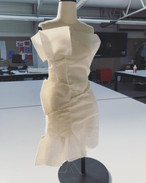26th October 2020
- Hannah G

- Nov 14, 2020
- 2 min read
Updated: Apr 5, 2021
Design
This week we had no lessons so I decided to work a bit more on the surgical cutting project. I selected one of the initial mini mannequin stand ideas and developed it into a full-scale toile. After recreating the sample in paper and placing it on the stand I could see that it was far too big. So I reduced the size of the cuts and made the ones on the top half (bodice) even shorter to create a more flattering shape on the body. Next I saw that that pattern needed a dart of something to draw in the waist on the opposite side of the surgical cutting detail. Experimenting with a smaller version of the surgical cutting technique I was able to create a more fitted shape. However, the extra detail distracted from the main feature so changed it to a simple dart instead. When it came to making up the toile, I choice plain cotton. But as soon as I started sewing it together, I could see that the fabric was far too flimsy to hold the surgical cutting detail, therefore I added interfacing to help maintain the shapes. A sturdier fabric such as leather, denim or dupion silk would have been more suitable. The waist darts also didn’t seem to sit correctly, so this would need to be fixed on the pattern. But overall I was happy with the outcome with the limited time I had to do it.
Research
I didn’t really do any project proposal work this week but I did watch a lecture called MISSING: Diverse stories of fashion and textiles. This lecture was really interesting I have no knowledge about Jamaican or Caribbean fashion and textiles. Clothing is used a sense of self for African people and everything has a meaning or reason being it. The guest speakers spoke about how sustainability has always been part of African textiles such as straw plaiting in the Bahamas. But it is not recognised as being sustainable, like similar crafts in other parts of the world. Black craft is often forgotten and either not documented or miss documented in archives. There were black women in Vogue and Tatler in the 1960’s but these designers are not mentioned within fashion books. These designers designed clothes for a market that couldn’t afford to buy their clothes, creating a strange juxtaposition. But fashion and textiles was an important part of building the Jamaican economy, with a main focus on resort wear for the tourist market. This resort wear focused on more American style and taste. It was interesting learning about these forgotten designers, makers and the importance of fashion within African culture.














Comments